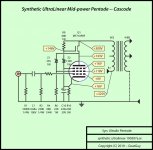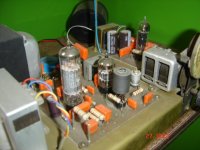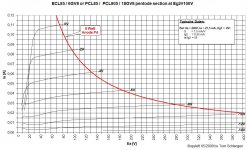You could use it in triode mode.But with Pa=8W max don't count on much more than 2,5W out.
The tube is more usefull in PP with the high permissible Ik.
Mona
The tube is more usefull in PP with the high permissible Ik.
Mona
As you know, the kink occurs when the plate voltage goes (too) far below the screen voltage.
Ketje had a good suggestion with triode operation, with the tradeoff of lower power.
Reducing the screen voltage to 150V will not move the kink voltage down enough. And lower screen voltage requires a less control grid bias; lower control grid bias looses dynamic range.
But there may be hope: If you really want to use that tube in SE, you might try experimenting with Ultra Linear. This method would work better with a 50% or 70% UL tap (the plate moves much faster than the screen on a 40% UL tap). Perhaps you could use a zener from the UL screen tap to the screen; that drops the initial screen voltage. You well need a resistor from the screen to ground. The resistor would maintain the minimum zener current, when the screen current drops to a minimum.
One of my latest SE amps uses a KT66 in UL, the tap is 50%. I used UL as an operating mode between pentode and triode mode, but not because of any kink that may or may not exist. 50% was picked to move the KT66 closer to triode operation than a 40% tap does. 50% tap is 1.9 dB closer to triode wired than 40%. 70% tap is 4.86 dB closer to triode wired than 40%.
If you have a 40% tap SE transformer, wire it "upside down", swap plate and b+ leads, now it is 60% tap. 60% tap is 3.5 dB closer to triode wired than 40%.
Do not forget, swapping the plate and B+ leads will change the input to output phase of the amplifier. In stereo, if the amps have different phase, and you do not swap one loudspeaker's leads the bass will be cancelled, and the stereo image will be from the speaker positions and beyond; and there will be no sound between the loudspeakers (no center image).
Ketje had a good suggestion with triode operation, with the tradeoff of lower power.
Reducing the screen voltage to 150V will not move the kink voltage down enough. And lower screen voltage requires a less control grid bias; lower control grid bias looses dynamic range.
But there may be hope: If you really want to use that tube in SE, you might try experimenting with Ultra Linear. This method would work better with a 50% or 70% UL tap (the plate moves much faster than the screen on a 40% UL tap). Perhaps you could use a zener from the UL screen tap to the screen; that drops the initial screen voltage. You well need a resistor from the screen to ground. The resistor would maintain the minimum zener current, when the screen current drops to a minimum.
One of my latest SE amps uses a KT66 in UL, the tap is 50%. I used UL as an operating mode between pentode and triode mode, but not because of any kink that may or may not exist. 50% was picked to move the KT66 closer to triode operation than a 40% tap does. 50% tap is 1.9 dB closer to triode wired than 40%. 70% tap is 4.86 dB closer to triode wired than 40%.
If you have a 40% tap SE transformer, wire it "upside down", swap plate and b+ leads, now it is 60% tap. 60% tap is 3.5 dB closer to triode wired than 40%.
Do not forget, swapping the plate and B+ leads will change the input to output phase of the amplifier. In stereo, if the amps have different phase, and you do not swap one loudspeaker's leads the bass will be cancelled, and the stereo image will be from the speaker positions and beyond; and there will be no sound between the loudspeakers (no center image).
It seems you enjoy a difficult challenge 😉 This valve was designed for vertical deflection of a 110 deg CRT. There were usually 2 preset pots to tweak out the non-linearity.
Update notes... (only, no value changes)
Attachments
Last edited:
Don't use it in Pentode, look into using it in screen drive or twin drive! 🙂
I would first investigate twin drive... but hey, there is this thread on a great idea for this tube as well:
ECL85/6GV8 PP Supertriode
Check it out. 😉
I would first investigate twin drive... but hey, there is this thread on a great idea for this tube as well:
ECL85/6GV8 PP Supertriode
Check it out. 😉
Last edited:
ECL85 has been designed for vertical oscillator and output in tube B&W TV's, where kink would be visible, not audible. I am using it in a regenerative receiver for AM using it in ultralineal classic way (Tap in the output trafo) with no problem at all.
Attachments
The kinks are one of th reasons why the datasheets specify the power output at a THD of 10 %, just to get rather big values. And this is for dedicated AF power tubes, which the PCL85 isn't.
As said before, a tube TV with a pentode frame deflection amplifier usually had controls to adjust frame linearity that often are accessible without the need of removing the back wall.
Best regards!
As said before, a tube TV with a pentode frame deflection amplifier usually had controls to adjust frame linearity that often are accessible without the need of removing the back wall.
Best regards!
Hi mashaffer,
Head for lower Eg2 and enjoy a more useful operation area you can put your loadline in. Principle works for many tv deflection duty type beam tetrodes. Example plot for power section of ECL85 / 6GV8 or PCL85 / PCL805 / 18GV8 attached. Sorry, no plot for Eg2 = 80V yet 😉
Regards, Tom
How do you deal with kinky pentode curves such as those for 6GV8/PCL85 when designing a SE amp with them? It would seem one would want to stay away from that region but is pretty hard to do within power specs.
Head for lower Eg2 and enjoy a more useful operation area you can put your loadline in. Principle works for many tv deflection duty type beam tetrodes. Example plot for power section of ECL85 / 6GV8 or PCL85 / PCL805 / 18GV8 attached. Sorry, no plot for Eg2 = 80V yet 😉
Regards, Tom
Attachments
Hi Tom,
Do you have all your graphs up on a website somewhere? A lot of old links lead to your long gone website MyNetCologne - Seite nicht gefunden
Do you have all your graphs up on a website somewhere? A lot of old links lead to your long gone website MyNetCologne - Seite nicht gefunden
My experience with pentodes is that the lower the screen voltage, the less kinky behavior and less distortion. I always use the lowest screen voltage that I need to get the knee of the Vg=0 curve where I need it.
I did some experiments trying to get extreme voltage swings from a CCS-loaded EL34 at low distortion. I had a 1100V supply to play with and varied idle plate voltage and screen supply voltage to find lowest distortion. It ended up that the circuit performed best when idle plate voltage was as high as possible (which moves the operating point away from the kinky area in the low plate voltage, low plate current zone). Also, when I was driving down into that zone, lower screen voltages reduced distortion.
I ended up getting 320Vrms output at .06% THD. That was with a 600V idle plate voltage and 35V on the screen and a 10mA CCS load.
I did some experiments trying to get extreme voltage swings from a CCS-loaded EL34 at low distortion. I had a 1100V supply to play with and varied idle plate voltage and screen supply voltage to find lowest distortion. It ended up that the circuit performed best when idle plate voltage was as high as possible (which moves the operating point away from the kinky area in the low plate voltage, low plate current zone). Also, when I was driving down into that zone, lower screen voltages reduced distortion.
I ended up getting 320Vrms output at .06% THD. That was with a 600V idle plate voltage and 35V on the screen and a 10mA CCS load.
SpreadSpectrum,
That was a great study!
That sounds like a great driver stage for a high power RF output tube that has up to 450V of grid bias.
But I am glad that I don't need that kind of power.
That was a great study!
That sounds like a great driver stage for a high power RF output tube that has up to 450V of grid bias.
But I am glad that I don't need that kind of power.
Last edited:
SpreadSpectrum,
That was a great study!
That sounds like a great driver stage for a high power RF output tube that has up to 450V of grid bias.
But I am glad that I don't need that kind of power.
I had thought that if I ever made an SE amp, it would be a cathode follower, so on a whim I decided to see if I could build a driver that would drive such an output stage with low distortion. It also has application in my homemade Unity-Coupled amp which needs 160Vrms to drive the output stage to clipping.
But yeah, I learned some cool things about how to best use pentodes, which I think can improve the characteristics of this tube. Just lower the screen voltage and the kinkiness should get somewhat better. It might also be a good idea to grab a less kinky tube if that is a possibility. This one doesn't seem particularly great and will probably yield high distortion.
I had thought that if I ever made an SE amp, it would be a cathode follower, so on a whim I decided to see if I could build a driver that would drive such an output stage with low distortion. It also has application in my homemade Unity-Coupled amp which needs 160 VRMS to drive the output stage to clipping.
But yeah, I learned some cool things about how to best use pentodes, which I think can improve the characteristics of this tube. Just lower the screen voltage and the kinkiness should get somewhat better. It might also be a good idea to grab a less kinky tube if that is a possibility. This one doesn't seem particularly great and will probably yield high distortion.
Tho' the design I posted didn't generate replies yet, I think it is a general purpose idea that grabs your position and allows the experimenter to “run with it” in almost any sense that makes sense to follow.
Just saying,
GoatGuy ✓
PS... did you mean 160 mVRMS? ... just wondering
But yeah, I learned some cool things about how to best use pentodes, which I think can improve the characteristics of this tube. Just lower the screen voltage and the kinkiness should get somewhat better.
A couple of years ago I went to a lecture of Bernard Terlingen, who explained how he had made very cheap audio power amplifiers using old TV horizontal sweep valves (beam tetrodes). After lots of experimenting, he had come to the same solution as you: using the lowest possible screen grid voltage to minimize the kinks.
He used the amplifiers and a bunch of loudspeakers to play the Hallelujah from Handel's Messiah precisely at midnight every new year. Everything was very low cost: the enclosures of the loudspeakers were cases of old sewing machines and the amplifiers were built into high-voltage cages from old televisions.
Anyway, his lectures are highly recommended for anyone who is interested in valves and understands Dutch. Most of them can be found on the internet.
Tho' the design I posted didn't generate replies yet, I think it is a general purpose idea that grabs your position and allows the experimenter to “run with it” in almost any sense that makes sense to follow.
Just saying,
GoatGuy ✓
PS... did you mean 160 mVRMS? ... just wondering
Sure, it keeps the plate voltage fairly constant, thus avoiding the kinky area.
I did mean 160Vrms for the other amp, it is a 50% CFB configuration so takes a lot of voltage drive.
- Status
- Not open for further replies.
- Home
- Amplifiers
- Tubes / Valves
- Dealing with Kinky Pentodes





